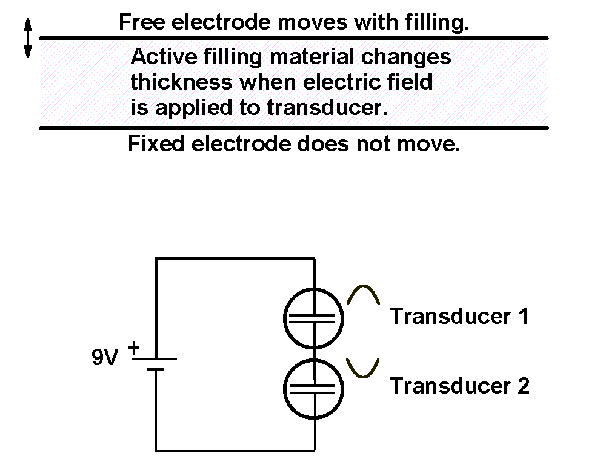Experiment of The Month
Interference Between Two Phase-Locked Acoustic Transducers
The MU Physics Department does not claim to have invented these labs. The origin of these labs is currently unknown to us. Our labs do not have written instructions. In keeping with this spirit, the description given here will be brief and general. The intent is that each performance of the lab will be unique; in each nature will reveal a slightly different face to the observer.
This month's exercise is a simple demonstration that sound has wave properties It used two Radio Shack "buzzers" and one 9 Volt battery. It can be extended to measure the speed of sound in air, provided that the frequency of the buzzer is known.
This exercise was part of a 1999 summer workshop on quantum physics. The observed wave character of sound was contrasted with the observation of a particle character for sound, based on low temperature heat capacity measurements.
The "buzzers" used for the experiment were Radio Shack part number 273-060A, although other similar units also work. Instead of "buzzing" these devices actually emit a reasonably pure tone. Older readers will recall a similar device marketed under the name "Sonalert." They will be called by the generic name "transducer" in the text that follows.
The transducer is built around this property of (some) materials: When an electric field is applied to a sample of the material, the sample changes thickness. The materials in which this phenomenon was originally explored (such as quartz) are called piezoelectric materials.
The transducer is constructed like a capacitor, with two plates separated by a dielectric material. In this case, the material is "active:" It changes thickness when an electric charge is applied to the capacitor plates.

If the lower plate of the capacitor is fixed, as in the figure, the upper plate vibrates up and down as an alternating EMF is applied to the capacitor. This vibrating plate generates a sound wave at the frequency of the applied AC EMF.
The Radio Shack "buzzers" have additional circuit elements so that instead of applying an external AC signal, one need only apply DC power. The 273-060 is listed for operation between 4V and 28V, DC. In this experiment, two of the transducers are connected in series with a 9V battery. Assuming that the potentials are roughly equal across each transducer, we note that each experiences a potential of about 4.5 V, just above the threshold for operation.
Near the "turn-on" threshold, a small perturbation in supply voltage can influence the behavior of the transducer. Suppose for example that the upper transducer has expanded because the filling material has expanded. This reduces the capacitance and increases the voltage drop across that capacitor. In turn, the voltage drop across the lower transducer is reduced, and it tends to drop out of oscillation.
When the upper transducer shrinks again, its capacitance increase, its voltage drop decreases, and the lower transducer "sees" a large enough voltage to return to oscillation. Oscillators tend to start up the same way each time they are turned on. If this is true for the lower transducer, then it behaves the same each time the upper transducer goes through a maximum in its thickness.
The upshot is that the two transducers are "phase locked." The crest of the lower transducer follows a fixed time later than the crest of the upper one. In practice, we have usually observed that the lower transducer is 180 degrees out of phase with the upper transducer.

Because the two transducers have a well-defined phase relationship, it is possible to hear interference in the sound that they generate. The figure shows two transducers held so that they radiate "forward" towards the camera. With the observer listening from this "forward" location, the hands move the transducers. With a frequency of about 3kHz, interference maxima should occur about each 10 cm. (If the transducers are 180 degrees out of phase, then an interference minimum will be heard when their separation is zero.)
If the frequency is measured, or if the manufacturer's value is accepted, then a measurement of the distance between interference maxima (one wavelength) leads quickly to the speed of sound in air. It helps to do the quantitative measurement in an environment with no "echos." It works reasonably well in a large laboratory room with the meter stick (in the photo) hanging off the edge of a lab bench.